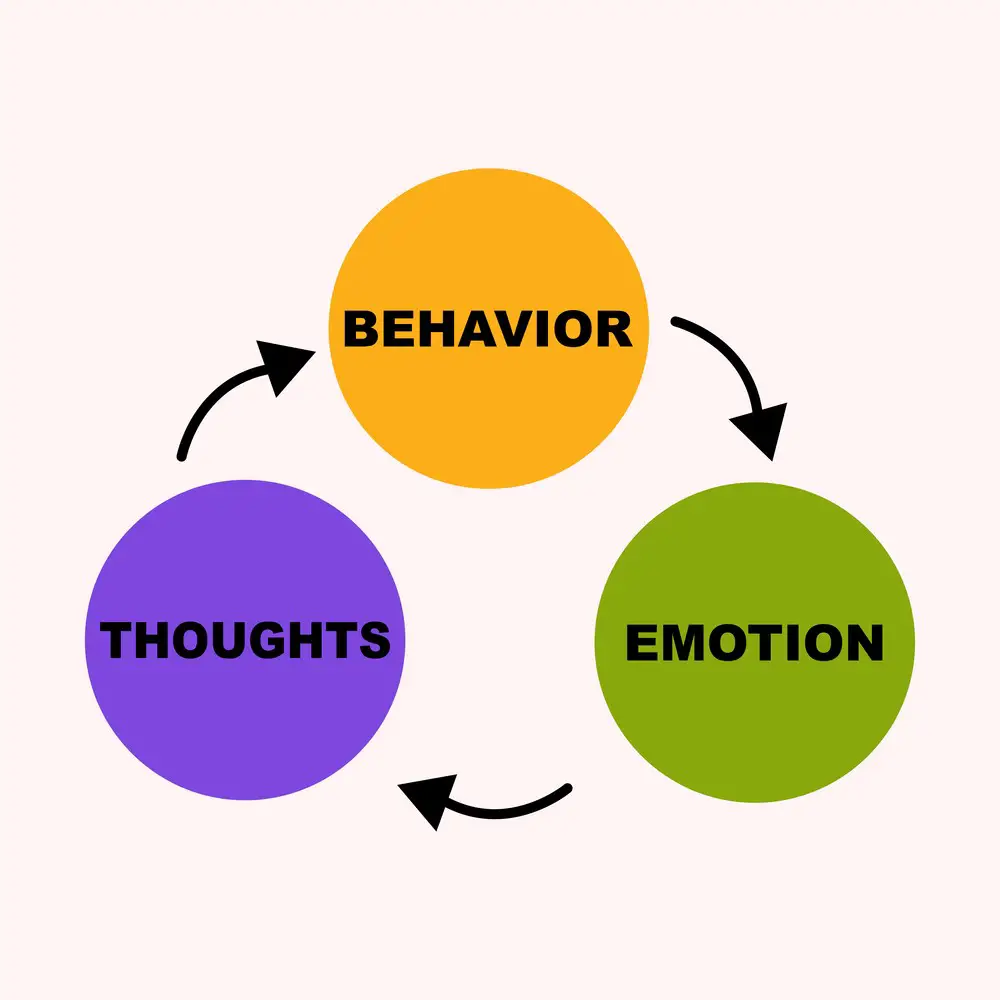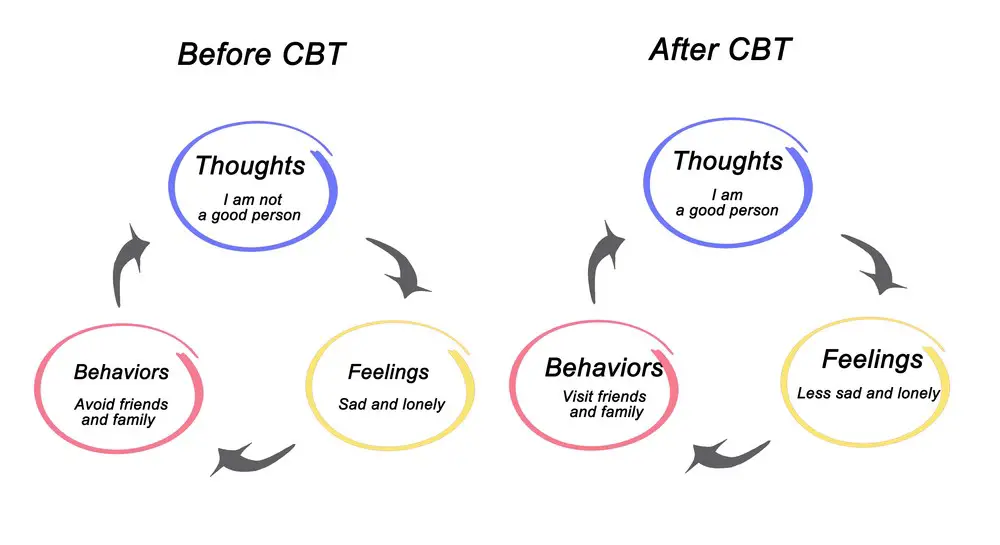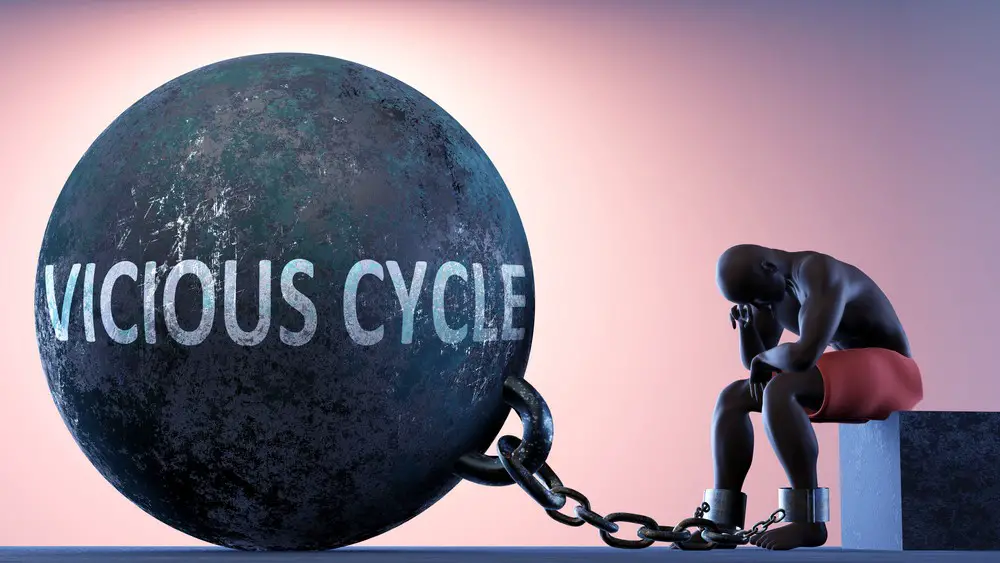As a BetterHelp affiliate, we receive compensation from BetterHelp if you purchase products or services through the links provided
Anxiety is a normal and adaptive emotion we all experience in response to stress. However, when anxiety becomes constant and interferes with our ability to function in day-to-day life, it may be time to seek professional help.
When you are experiencing anxiety, it can feel like you’re stuck in a constant anxiety cycle. Understanding that this is a cycle can help manage it and that millions of other people worldwide are also struggling can help you feel less alone.
Recognizing the anxiety cycle, when you’re in it, and ways to break it can help you manage and reduce your anxiety.
What is the Anxiety Cycle?
The anxiety cycle is a pattern of thoughts, emotions, and behaviors that can fuel anxious feelings and make them worse. The cycle begins with an anxious thought or worry, which leads to increased anxiety and arousal.
This, in turn, can lead to avoidance behaviors (e.g., not wanting to leave the house) or safety behaviors (e.g., carrying around a lucky charm).
The avoidance and safety behaviors then reinforce the anxious thought, leading to further anxiety and further avoidance or safety behaviors in a vicious cycle.
This can feel like a vicious loop that is impossible to break, so recognizing the cycle is the first step towards stopping this roundabout of heightened anxiety.
How to Identify the Stages of the Anxiety Cycle?
If you’re not sure whether you’re caught in the anxiety cycle, ask yourself the following questions:
- Do I have anxious thoughts or worries that seem never to go away?
- Do I avoid certain people, places, or things because I fear what might happen?
- Do I do things that help me feel better in the moment but may make my anxiety worse in the long run (e.g., using alcohol or drugs to self-medicate)?
If you answered yes to any of these questions, you’re likely caught in the anxiety cycle.
Many people find themselves in the middle of a cycle of anxiety from time to time. Still, when this cycle becomes a regular occurrence, it can lead to anxiety disorders and other mental health issues. Getting a grasp on the cycle and learning how to break it can help you reduce your anxiety, better understand yourself and your reactions, and manage anxiety more effectively.

An Example of the Anxiety Cycle
Seeing the anxiety cycle in action can help you understand and identify it when you’re in it.
Let’s say you are getting ready for an upcoming job interview. Your initial thought might be that you’re not qualified for the job and won’t make a good impression on the interviewer (stage 1).
This anxious thought can lead to worry and fear, which then triggers avoidance behaviors such as procrastinating on preparing for the interview (stage 2).
Your avoidance reinforces the initial anxious thought, leading to further anxiety and avoidance or safety behaviors in a vicious cycle (stage 3).
Because you never faced your fear, your thoughts weren’t challenged about the ‘fearful’ situation, and so you continue to be fearful. This cycle continues until you intervene and break it.
How to Break the Cycle of Anxiety
Now that you know when to recognize and identify the anxiety cycle, the next step is to learn how to break it. This is a really difficult task, but it is possible. Putting in the time to practice, evaluate, and re-practice techniques to break the cycle is key.
Here are some strategies for breaking the cycle of anxiety:
Challenge Your Anxious Thoughts
Ask yourself if there is any truth to what you’re telling yourself. For instance, if you think that everyone at work will think you’re a failure, ask yourself if there’s evidence to back this up.
This isn’t about telling yourself that you’re wrong or being harsh on yourself; it’s trying to look at your situation from the opposite point of view and reason with yourself what is the truth.
Positive Self-Talk
Once you’ve identified and challenged any irrational thoughts, replace them with more realistic and positive statements about yourself. You can only help yourself if you’re kind to yourself.
It’s good practice to talk to yourself as you would a friend or family member and give yourself words of encouragement.
Take Action
To break the cycle of avoidance and safety behaviors, you must challenge your fear by taking small steps to face what makes you anxious. Start with something small, like going for a short walk outside or attending a social event with a friend.
Don’t throw yourself in the deep end because this can be overwhelming and counterproductive. Instead, start with manageable small steps and increase the difficulty of your challenges as you get more comfortable.
Seek Professional Medical Help
If you’re finding it difficult to break the cycle of anxiety on your own and need more support, seeking help from a qualified mental health practitioner can be extremely helpful in managing your anxiety.
A mental health professional will be able to provide you with the tools and techniques you need to manage your anxiety, as well as provide a listening ear to help process any underlying issues that may be contributing to your anxious thoughts.

How Do Therapists Use The Anxiety Cycle?
Cognitive behavioral therapists often use the anxiety cycle to conceptualize their clients’ difficulties and devise treatment plans accordingly.
In therapy, you’ll learn how to identify your version of the anxiety cycle to break free from it. Once you understand how your individualized cycle works, you and your therapist can develop specific strategies for each stage of the cycle aimed at reducing your anxiety levels.
A therapist can also diagnose you with anxiety disorders, like generalized anxiety disorder (GAD), panic disorder, or social anxiety disorder (SAD), provide you with more targeted treatment, and advise you on how to reduce your anxious thoughts and anxious symptoms.

Conclusion: Breaking Free From the Anxiety Cycle
While it might feel impossible to break free from an anxiety cycle, it is possible with the right approach and support. Working with a therapist or psychologist can help you identify how your individualized cycle works and provide you with practical strategies to manage your anxious thoughts and behaviors.
By challenging yourself in small steps, engaging in positive self-talk, and changing the way you think, you can break free from the anxiety cycle and live a life that isn’t dominated by fear.
If you’re finding it difficult to manage your anxiety alone, please don’t hesitate to reach out for help from a qualified mental health professional. With the right support and guidance, it is possible to take control of your anxiety and live a more fulfilling life.
FAQs.

- 3 Ways Wearing a Hat Can Help Lower Your Stress Levels - April 19, 2025
- Breaking the Silence: Why Men’s Mental Health Matters More Than Ever - April 15, 2025
- How to Transform a Home’s Patio Space into a Relaxing Space - March 23, 2025
This site contains affiliate links to products. We will receive a commission for purchases made through these links.



